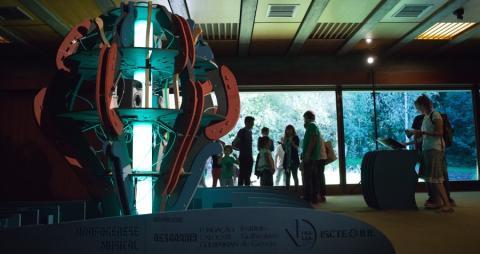Control of Aquatic Drones for Maritime Tasks
Local Coordinator
Main Objective: The primary contribution of the project will be twofold: (i) we will demonstrate a number of collective behaviors on a system of aquatic drones to show that systems of such drones have the potential to take on important maritime tasks, and (ii) we will explore the application of our novel hybrid approach to the synthesis of self-organized controllers for multirobot systems.
Project Information
2014-04-01
2015-07-01
Project Partners
Musical Morphogenesis
Researcher
Musical Morphogenesis (2014-2017)
The interactive installation “Musical Morphogenesis” is a multidisciplinary project based on 5 main disciplines: computational biology, music, architecture, robotics, and science communication. The implementation of all components of the installation had to take into consideration the specificities of each discipline, turning this into an extremely challenging project. The main objective of “Musical Morphogenesis” was to take the visitors in a sensorial journey to explore the dynamic interactions of genes and proteins during the development of an organ. Such biological processes are highly complex, and the same set of genes can originate different organs depending on when they are activated. Taking advantage of a mathematical model that address the genetic network of the Arabidopsis thaliana flowers, a team of computational biologists, musicians, architects, engineers and science communicators joined hands to create an installation that could explore the development of flowers. The installation was composed of a robotic wood-made flower, which kinetics reflected the progression of the genetic network, and of an interface to interact with the installation. Visitors could turn on or off one or more genes, and eventually switch the network towards the formation of a different organ originating a mutant. To facilitate the comprehension of the network, each gene had a specific sound.
Project Information
2014-01-01
2017-12-31
Project Partners
- ISTAR-Iscte (DLS)
- DINAMIA'CET-Iscte (CT)
- Calouste Gulbenkian Foundation - (Portugal)
- FABLAB-IUL - (Portugal)
- Gulbenkian Science Institute - (Portugal)
Remote Piloted Semi-Autonomous Aerial Surveillance System Using Terrestrial Wireless Networks
Researcher
The main objective of SAAS is to develop an UAV remote control system that is mostly independent of a specific vehicle model or design and that makes use of the available terrestrial wireless networks. The individual challenges and objectives to be addressed are:• Real-Time Video Transmission and Control using Terrestrial Wireless Networks: Investigate the possibility of transmitting real time video and control commands with adequate quality for a pilot to control and make decisions on the vehicle course using the available radio networks (GSM, UMTS, HSDPA, Wi-Fi, LTE).• Semi-autonomous Flight Control: Develop autonomous control capabilities for the aircraft to perform its self-rescue in the case of loss of radio connection and that can also allow a reduced piloting workload.• Remote Visualization and Control Application: Implement an application for tablet PCs that enables the visualization of the video captured by the aircraft cameras together with other telemetry information and allows the pilot to command the aircraft (either using the touchscreen, the accelerometers or an additional attached joystick).• Prototype Implementation and Flight Tests: Implement a prototype using a small rotary-wing aircraft (possibly a tricopter/quadcopter) and evaluate the performance in terms of video reception, control, and autonomy capability.
Project Information
2012-03-01
2014-04-01
Project Partners

 Português
Português


